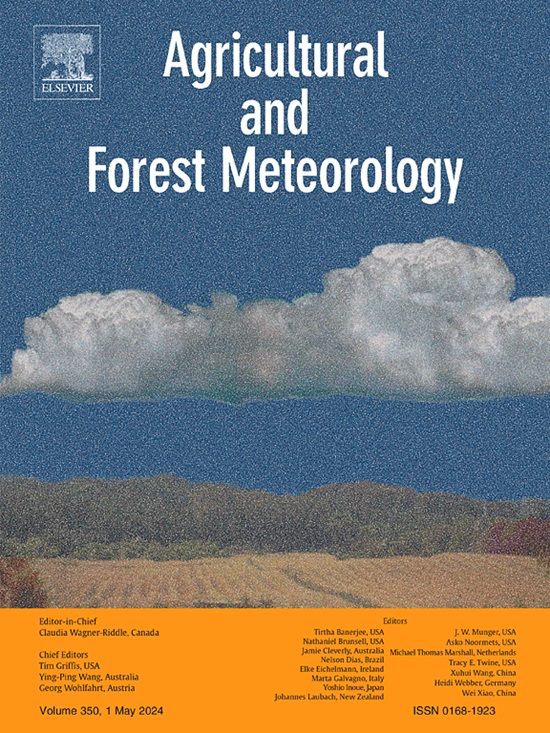人工林对中国地表温度的调节作用
IF 5.7
1区 农林科学
Q1 AGRONOMY
引用次数: 0
摘要
植树造林已被视为减缓气候变暖的潜在有效战略。20世纪70年代以来,中国实施了一系列大规模的植树造林和再造林工程,拥有世界上最大的人工林面积。人工林被广泛认为是一个持久的碳汇。然而,PF通过生物物理过程对气候的调节作用尚不清楚。为此,我们利用卫星观测数据量化了2003 - 2012年草地(GRA)、农田(CRO)和天然林(NF)向PF转化对地表温度(LST)的影响,并基于改进的内在生物物理机制(IBM)方法阐明了潜在的生物物理机制。结果表明:与NF相比,PF的日降温效果(- 0.005±0.002 K)可以忽略,而与GRA(- 0.253±0.004 K)和CRO(- 0.162±0.002 K)相比,PF的日降温效果明显;我们还证明了修正后的IBM归因方法适用于解释PF对LST的生物物理机制。归因分析表明,在将NF、GRA和CRO转换为PF后,表面粗糙度和Bowen比主导了降温效应,表面变得更粗糙,蒸发降温作用更强,反照率的贡献相对其他分量不明显,增温效应较弱。此外,大气反馈对地表温度有显著影响,应纳入地表温度变化的归因。本研究重点探讨了林分造林对当地气候适应效益的潜力,填补了以往研究在区分林分和林分时生物物理效应失效的空白,为实施林业项目时当地气候影响评价提供了新的指导。本文章由计算机程序翻译,如有差异,请以英文原文为准。
Regulation effect of planted forests on land surface temperature in China
Afforestation has been regarded as a potentially effective strategy for the mitigation of climate warming. China has the largest planted forest area worldwide benefited by a series of large-scale afforestation and reforestation project since the 1970s. The planted forests (PF) have been widely reported as an enduring carbon sink. However, the climatic regulation effect of PF on climate through biophysical process remains unclear. To this end, we utilized satellite observations to quantify the impact of the conversion of grasslands (GRA), croplands (CRO) and natural forests (NF) to PF on land surface temperature (LST) between 2003 and 2012 and illustrated the underlying biophysical mechanisms based on a revised Intrinsic Biophysical Mechanism (IBM) method. The results indicated that afforestation of PF caused negligible daily cooling effect (−0.005 ± 0.002 K) compared with NF while induced obvious daily cooling effect compared with GRA (−0.253 ± 0.004 K) and CRO (−0.162 ± 0.002 K). We also demonstrated that the revised IBM attribution method is applicable in interpreting the biophysical mechanism of PF on LST. Attribution analysis revealed that the surface roughness and Bowen ratio dominated the cooling effect as the surface became rougher and more evaporative cooling after converting NF, GRA, or CRO to PF. The contributions of albedo were less stark compared with other components and presented a weak warming effect. Furthermore, the atmospheric feedback was proved that have a pronounced impact on LST and should be included in the attribution of LST change. This study focuses on the potential of PF afforestation to provide local climate adaptation benefits, filling the gaps of previous studies involved to biophysical effect failure in distinguishing NF and PF, and provides new guidance for local climate impact evaluation when implementing forestry projects.
求助全文
通过发布文献求助,成功后即可免费获取论文全文。
去求助
来源期刊
CiteScore
10.30
自引率
9.70%
发文量
415
审稿时长
69 days
期刊介绍:
Agricultural and Forest Meteorology is an international journal for the publication of original articles and reviews on the inter-relationship between meteorology, agriculture, forestry, and natural ecosystems. Emphasis is on basic and applied scientific research relevant to practical problems in the field of plant and soil sciences, ecology and biogeochemistry as affected by weather as well as climate variability and change. Theoretical models should be tested against experimental data. Articles must appeal to an international audience. Special issues devoted to single topics are also published.
Typical topics include canopy micrometeorology (e.g. canopy radiation transfer, turbulence near the ground, evapotranspiration, energy balance, fluxes of trace gases), micrometeorological instrumentation (e.g., sensors for trace gases, flux measurement instruments, radiation measurement techniques), aerobiology (e.g. the dispersion of pollen, spores, insects and pesticides), biometeorology (e.g. the effect of weather and climate on plant distribution, crop yield, water-use efficiency, and plant phenology), forest-fire/weather interactions, and feedbacks from vegetation to weather and the climate system.

 求助内容:
求助内容: 应助结果提醒方式:
应助结果提醒方式:


